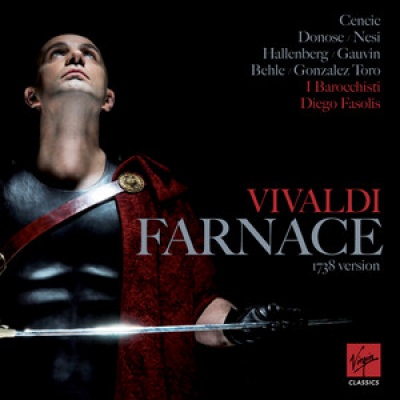
Vivaldi Il Farnace
“A work bursting with riches … This powerful operatic tragedy is one of the highlights of Vivaldi’s canon,” says the Vivaldi expert Frédéric Delaméa who, with the conductor Diego Fasolis has reconstructed the never-performed version of Farnace that Vivaldi prepared for Ferrara in 1737-38. In this world premiere recording the magnificent cast is led by the brilliant countertenor Max Emanuel Cencic in the title role. Beyond a thrilling line-up of performers, this recording offers collectors the opportunity to enjoy a world premiere of the version of Farnace that Vivaldi prepared specially for the city of Ferrara in 1737-38 after its success in Venice. This is not only the first time the Ferrara Farnace has been recorded, but also the first time it has been heard -- since the planned performances in the city in 1738 were cancelled following the local failure of the Vivaldi opera that preceded it, Siroe. It is possible that Vivaldi in fact never completed this dramma per musica – the score of the first two acts only is extant, preserved in Vivaldi’s own personal library – but the third act has been reconstructed by the conductor Diego Fasolis and the Vivaldi expert Frédéric Delaméa. Delaméa describes Farnace as “a work bursting with riches … The splendour of the music composed or adapted for Ferrara makes this powerful operatic tragedy one of the highlights of Vivaldi’s canon.” Fiesolis was also in charge of Virgin Classics’ version of Handel’s opera Faramondo, which The Guardian described as “... devastatingly realised … The whole thing is a revelation.” Max Emanuel Cencic also took the title role there, prompting the The Guardian to continue by saying that the recording represented “countertenor heaven”. The Neue Zürcher Zeitung has described Cencic as combining “stupendous technical virtuosity with warmth of feeling and dramatic temperament … his flexibility is splendid, his palette of colours abundant.” The Croatian countertenor is not the only star singer in this recording. He is joined from North America by two sopranos – Karina Gauvin, a singer who brings both rich tone and exquisite Baroque style, and Michael Maniaci (a true male soprano as a opposed to a countertenor) – and from Europe by the Swedish mezzo Ann Hallenberg (an expert in the Farinelli repertory), the Romanian mezzo Ruxandra Donose (renowned in Rossini) and two contrasting Swiss tenors, Daniel Behle and Emiliano Gonzales Toro. An introduction by F. Delaméa For Vivaldi, the city of Ferrara was not associated with good fortune. In the autumn of 1737, Tommasso Ruffo, Cardinal Archbishop of the city and a Papal Legate, had forbidden Vivaldi from presenting his operas at the Teatro Bonacossi on the grounds that the Venetian ‘Red Priest’ no longer said Mass and was “friendly with the female singer Girò”. This was an enormous blow to Vivaldi and his finances, and he found himself forced to return immediately to Venice to mount a new season of opera. The following year, however, Ferrara opened up to Vivaldi once again, since the reproving cardinal had stepped down from his duties, and the composer decided to stage revised versions of two of his operatic successes: Siroe re di Persia et Farnace. As fate would have it, Siroe proved a failure with the audience in Ferrara, and the performances of Farnace were cancelled as a result, with the theatre instead deciding to stage an opera by Johann Adolf Hasse. In fact, Farnace was never staged again anywhere, and the only surviving trace of its music is in the form of an incomplete score -- the first two acts of the opera, notated with care -- preserved by Vivaldi in his personal collection. The title page carries an epitaph-like inscription in Vivaldi’s own hand: Musica del Vivaldi – 1738. Vivaldi’s is the seventh documented setting of a libretto by Antonio Maria Lucchini and it stands as the last surviving opera by the composer. It is the only remaining opera of Vivaldi never to have been performed since the composer’s time, and, unlike all the others, has remained unrecorded until now. The chances are that Vivaldi never completed this dramma per musica, but now, with the reconstruction of the third act by Diego Fasolis and Frédéric Delaméa, we have the opportunity to discover a work bursting with riches, the last fruit of Vivaldi’s unprecedented operatic output. The splendour of the music composed or adapted for Ferrara makes this powerful operatic tragedy one of the highlights of Vivaldi’s canon.
